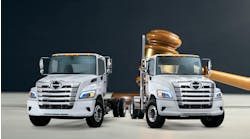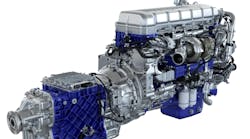It's funny how in the age of social media and near-instant communication you rarely get a real, live, letter any more. But that's exactly what happened on the heels of my recent Fleet Owner blog, when I noted that electric hybrid drive systems would, in all likelihood, be a part of the OEM formula for meeting Phase 2 Greenhouse Gas (GHG 2) regulations when they come into law a decade from now.
A letter from Lightning Hybrids CEO Tim Reeser noted that diesel-electric hybrids aren't the only option available to OEMs wrestling with GHG 2 powertrain requirements. Hydraulic-electric hybrid drivetrains also offer a significant low-end torque boost, to help trucks get up and moving more efficiently and burning less fuel in the process.
And Mr. Reeser is correct: I've been covering heavy trucks now for over 20 years. And all that time, I've never had the opportunity to test-drive a hydraulic hybrid drivetrain, or even inspect one up close. So I called Mr. Reeser to get a bit of a primer on these systems, which are already making inroads in refuse applications, due to the stop-and-start nature of that application.
Reeser told me that his company's system, is a relatively simple way of converting kinetic energy generated when a truck brakes into hydraulic energy, which is then released and used to provide extra torque when the truck gets under way again.
Here is a brief explanatory video from Lightning Hybrids:
The system can be installed on a truck as an upfit, or retrofitted to older vehicles. (The company is currently in discussions with OEMs regrading offering it as an option on new vehicles.) The system consists of an dedicated, auxiliary hydraulic system, including a low-pressure holding tank, a high-pressure accumulator tank, a power transfer module, as well as an electronic control module and other components.
When the truck is moving down the road, the hydraulic fluid remains in the low-pressure storage tank until the vehicle's brakes are applied. At that point, the system uses the kinetic energy generated by the brakes to force the hydraulic fluid into the high-pressure accumulator tank, where it is stored until needed. When the brakes are released, the system's ECM reads all pertinent information off the vehicle's J1939 ECM, including throttle position, horsepower, torque, speed and other vital data, and immediately releases the hydraulic fluid at high pressure, where it flows into the system's power transfer module. This module is linked directly to the truck's transmission via a second driveshaft, where this additional torque is delivered directly to the drive axle, providing a significant low-end performance boost to the accelerating truck.
Reeser says battery capacity on electric hybrids limit the system's energy density to around 30 percent. But, he says, hydraulic hybrids capture close to 80 percent of the hydraulic fluid's energy density, resulting in a robust start-assist, which, he says, can yield fuel economy benefits from 15- to 35 percent for fleets – depending on application.
He notes that early hydraulic hybrid systems were much heavier and less reliable than systems available today. The industry has been able to leverage carbon fiber technology breakthroughs in natural gas fuel storage to develop new tanks and accumulators that weigh up to 1,000 pounds less than older systems. And recent advances in on-board vehicle control modules -- and his company's ability to tap effectively into those systems -- has resulted in consistently reliable, seamless performance for fleets and drivers alike.
For now, Reeser says Lightning Hybrids is beginning to work more closely with OEMs now that a clear GHG 2 pathway is visible, while also continuing to refine the technology. The results, he says, are promising, with next generation systems already 39 percent more efficient then their predecessors and costs steadily coming down to the point where he feels a 3 year return-on-investment for fleets will be feasible.
As I noted previously, it seems likely that hybrid drive systems will be an important tool to help OEMs meet GHG 2 regulations when they come into effect a decade from now. And although the public at large – and this writer – tend to think of electric systems when hybrids are mentioned, it's important to remember that hydraulic hybrids hold great promise as well for reducing emissions while boosting fuel economy in heavy truck applications.


